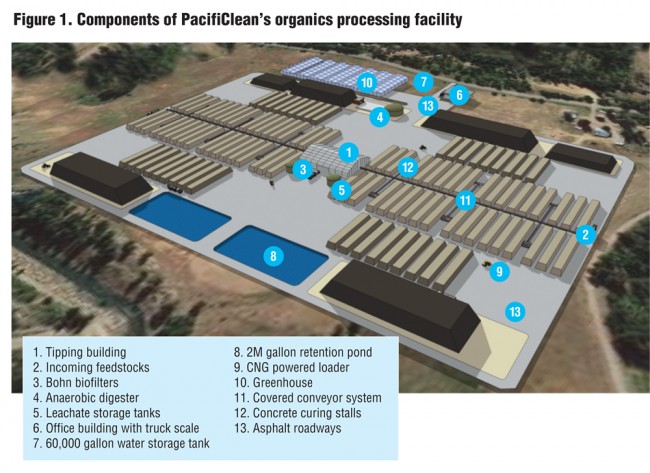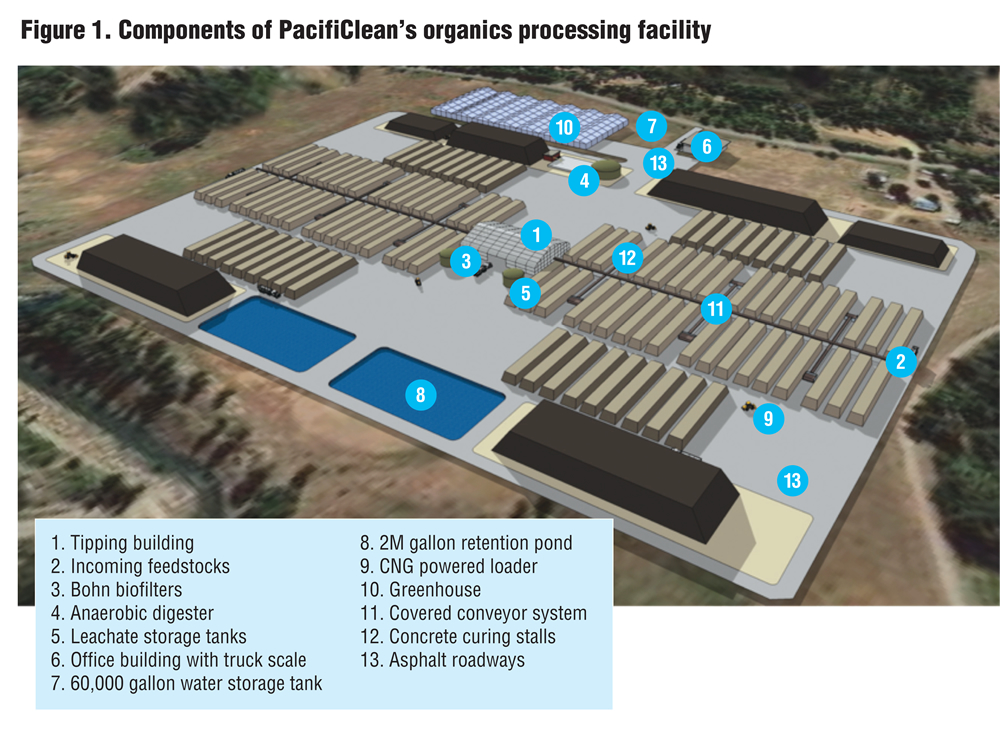PacifiClean Environmental is building a composting and anaerobic digestion facility about 90 miles from Seattle to process a wide range of source separated organics.
Nicole Rinauro
BioCycle March 2013, Vol. 54, No. 3, p. 52

Headquartered in Spokane, Washington, PacifiClean Environmental, LLC is pioneering a comprehensive and fully integrated regional organics management system in Central Washington that is scheduled to begin processing source separated organic materials in the spring of 2014. The company has an anchor contract with the City of Seattle and is also actively sourcing biosolids to provide Washington jurisdictions such as King County with an alternative to land application.
PacifiClean is led by Larry Condon, a composter and entrepreneur, and the principals of SRM Development, a commercial real estate developer. Condon got his start in organics processing at Barr-Tech, a Northwest composter whose customers include the City of Spokane and Spokane County, large supermarkets, universities, municipal jurisdictions and waste haulers. His partners at SRM Development, Dee McGonigle, Bryan Stone, and James Rivard, view organics processing facilities as a way to diversify their portfolio and generate consistent residual revenue.
Elk Heights Facility
PacifiClean procured 193 acres in Elk Heights, a rural area about 90 miles from Seattle. This property will support the entire spectrum of organic feedstocks and facilitate a generous buffer zone. Elk Heights is in close proximity to largely untapped Central and Eastern Washington agricultural markets with an estimated potential to utilize up to 256,000 cubic yards of finished compost annually. Project development is in the permitting phase; processing capacity will eventually be in the range of 200,000 tons/year. PacifiClean anticipates completion of permitting activities in the summer of 2013, site construction to begin soon thereafter, and commencement of processing operations by the spring of 2014.
Feedstocks to be processed include biosolids, green waste, curbside collected commingled food waste/green waste (residential organics), wood residuals and land clearing debris, commercial food waste and other separated organics and agricultural residuals. The residential and commercial organics will comprise the majority of the feedstocks received. Processing components or subsystems of the Elk Heights facility have been selected specifically to serve the generators in the Puget Sound Region and communities in Kittitas, Yakima, and surrounding counties. Component systems are shown in Figure 1.
 The facility is being designed with two processing lines — one to produce compost products made without biosolids, which will allow for use of the product on organic farms; a second incorporates biosolids as a portion of the feedstock mix. To increase operational efficiencies, enable separate acceptance and processing of biosolids, avoid processing redundancy, and allow for easy expansion of the facility as volumes increase over time, the tipping area is centrally located and divided into quadrants. PacifiClean is constructing a 180-foot by 120-foot by 35-foot building with air evacuated to four large biofilters. All materials excepting for biosolids will be delivered to the center of the tipping building. Biosolids will be unloaded at the opposite end of the building. Yard and food waste will be pushed to the appropriate corners. As materials are dumped, plastic and other noncompostable materials will be removed by hand. The tipping building will be covered in translucent panels to reduce the need for lighting. Its central location allows for the most efficient disbursement of materials from the building into active composting or anaerobic digestion.
The facility is being designed with two processing lines — one to produce compost products made without biosolids, which will allow for use of the product on organic farms; a second incorporates biosolids as a portion of the feedstock mix. To increase operational efficiencies, enable separate acceptance and processing of biosolids, avoid processing redundancy, and allow for easy expansion of the facility as volumes increase over time, the tipping area is centrally located and divided into quadrants. PacifiClean is constructing a 180-foot by 120-foot by 35-foot building with air evacuated to four large biofilters. All materials excepting for biosolids will be delivered to the center of the tipping building. Biosolids will be unloaded at the opposite end of the building. Yard and food waste will be pushed to the appropriate corners. As materials are dumped, plastic and other noncompostable materials will be removed by hand. The tipping building will be covered in translucent panels to reduce the need for lighting. Its central location allows for the most efficient disbursement of materials from the building into active composting or anaerobic digestion.
After contaminant removal, food and yard waste will be combined, ground and screened to remove large woody material and any remaining noncompostable materials. Leachate or storm water will be used to add moisture as necessary. After screening, the combined feedstock will be fed into a hopper then conveyed to an area to begin a 30 day, Phase I aerated composting utilizing the GORE® Cover system. Biosolids or blends that include biosolids will be treated separately, but identically. At the end of 30 days, the material will be moved to Phase II. It will be watered as needed to reach appropriate moisture and piled (with no forced aeration) Phase II continues for 15 days. During Phase I and II, piles will be monitored for stability, temperature, pH, and oxygen. After 15 days, the compost will be moved to Phase III for storing and aging.
Materials processing at the Elk Heights facility also will include a low solids (wet) anaerobic digestion process, primarily for food waste. Biogas will be scrubbed and compressed and utilized as vehicle fuel. PacifiClean has relationships with several technology providers but a final decision on AD and biogas equipment has not yet been made.
Materials Transfer And Contamination Management
PacifiClean’s fleet of 10 transfer trucks are specified with Cummins Westport ISX 15G natural gas engines that will use the compressed RNG (renewable natural gas). Included in the pending contract with the City of Seattle is the transfer of materials from City-owned and operated transfer stations. Seattle, which is in the process of upgrading its three transfer stations, will load PacifiClean’s 53-foot transfer trailers.
The quadrant design on the tipping floor enables PacifiClean to isolate more highly contaminated loads, characterize contaminants, narrow the pool of potential generators, and provide feedback to and collaborate with jurisdictions it is under contract with to continually reduce the amount of contaminants flowing through the facility. Visual inspection starts with a load check at the scale house. Scale software will be used to track and report the composition of every load of material coming into the facility; it will be especially useful in monitoring and troubleshooting contamination issues. Loads containing noncompliant material will be rejected. The hauler and source will be notified of the rejected material. A detention area will be maintained to allow for reloading, which will be attempted while the tipping vehicle is still present. Load inspection and contaminant sorting on the tipping floor will also prevent prohibited materials such as gypsum waste, demolition debris, painted or treated wood and hazardous wastes from entering the composting process.
Addressing Community Impacts
PacifiClean invested the time early on to get support for its project from the Ellensburg Business Development Authority, the Kittitas County Chamber of Commerce, and the Kittitas County Board of Commissioners. The Board of Commissioners wrote: ”We are excited about the industry this venture will bring into the County and the potential for related economic development opportunities which may result. We are also supportive of the jobs this project will bring, both during construction and ongoing operation. That the project demonstrates how to close the loop with respect to resource management is a tremendous plus. Finally, this project represents another example whereby existing resources are utilized to create energy in a sustainable way, a growing industry sector in our County and economy.”
Once the site was procured and permitting activities commenced, outreach began with site neighbors. Specialists were hired to study community impacts related to traffic, noise, air, view, and wildlife and habitat. Some studies are still underway, however, PacifiClean has been interfacing with residents to ensure their understanding of the project and the related impacts. A review of public comments indicated that area residents are primarily concerned with odor, view impacts, water quality and blowing compost, as well as traffic and noise. Each of these items is being addressed through a series of public meetings with additional mitigation provided where warranted. For example, both the composting area designation as well as the layout of composting operations takes wind patterns and velocity into consideration. In addition to employing GORE covered composting technology, finished product may also be covered.
Findings of the neighborhood impacts are summarized as follows:
Traffic: The traffic study assumed a constant delivery rate of 24 hours/day, 7 days/week, for approximately 350 days/year. Trucks delivering organic material are estimated to be 35 cubic yard (cy) capacity, with a load density estimated to range between 500 lbs/cy and 1,600 lbs/cy, with an average density of 1,000 lbs/cy. Trucks hauling topsoil and compost to the surrounding agricultural area are assumed to range between 20 cy and 100 cy in volume capacity, with material density around 1,000 lbs/cy. The study also assumes 11 initial staff members driving to and from the site daily and also takes into account service and auxiliary vehicles. All onsite traffic occurs on pavement and is situated away from composting piles, which will help decrease dust generation.
Noise: PacifiClean will use a covered, electric conveyor system to minimize use of loaders and electric-powered equipment to grind, shred, mix, and screen material. Grinding, shredding, mixing, and screening will also occur indoors (see Odor, below). Noise is projected to be below EPA code limits and existing ambient levels.
Odor: As described earlier, PacifClean will mix and screen all material in the enclosed tipping building, and utilize a covered aerated static composting system. Finished product will be covered to mitigate any odor and blowing material as necessary. Only 45 acres of 193 acre Elk Heights’ property is slated for site operations, creating a significant buffer to help mitigate odor and noise impacts.
View: The natural slope of the site helps veil the facility from view. The tipping building is located 40 feet below the roadway entrance, with the tallest point of the building being five feet below the roadway surface. All site activities will take place at least 300 feet from the roadway, with the tipping building located 700 feet away.
Water: The Elk Heights facility is designed for zero discharge of storm water to the environment. Water collection will occur from five site surface collection areas during fall, winter, and spring. Collected water will be utilized to moisten compost piles during active composting as well as for dust management and irrigation. These measures will eliminate the need to discharge water collected. Water from any point where it comes into contact with compost, such as below the GORE® covered piles, from inside the building, and from any additional mixing areas will be diverted to two 40,000 gallon leachate tanks. Water from transfer trailer and other heavy equipment storage areas, as well as from the surface of any uncovered compost product piles will be diverted to storm water retention ponds, as it may contain suspended solids. Water from these ponds will be used to add moisture to the composting process, control dust and conduct clean-up operations.
Nicole Rinauro is a waste industry consultant engaged in promoting innovative industry leaders through development of competitive proposals and strategies. She may be reached at n_rinauro@msn.com. For more information contact Larry Condon (larryc@pacificlean.net).










